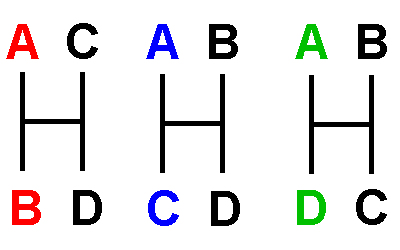

Maximum Parsimony with nucleotide data


Informative
SNP positions of
types 5, 6, & 7
favor the first, second, or third hypotheses of relationship,
respectively, because each of these types requires a single
nucleotide change in that hypothesis, and two changes in
the two alternative hypotheses.They are informative because
they provide evidence in favor of one & only one
hypothesis over the others.
Then, in a hypothetical data set [not
shown] with 10 Type 5
positions, 5 Type 6
positions, and 2 Type 7
positions,
Hypothesis #1 then requires N =
10
+ 2( 5 + 2) = 24
changes
Hypothesis #2
would require N = 5 + 2(10 + 2) = 29 changes
Hypothesis #3
would require N = 2 + 2(10 + 5) =
32 changes
Thus, the first hypothesis requires the fewest changes and is therefore the most parsimonious explanation of the data. Note that this hypothesis has the largest number of parsimony sites that favor it.
Uninformative
SNP positions of types 1, 2,
3, & 4 uniformly require 0, 1,
3, & 2 nucleotide changes,
respectively, in any of the hypotheses. They are uninformative
because they do not provide evidence in favor of any
one of the three hypotheses over the others. [SNP positions
of types 3 & 4 may be informative,
under certain models of molecular evolution].
HOMEWORK: A students asks, "The
most parsimonious explanation has the largest number of sites
that favor it. I don't understand: that seems backwards."
Explain the student's error.
HOMEWORK: SHOW that positions of types 1, 2, 3, & 4 require 0, 1, 3, & 2 nucleotide changes, respectively, for any of the three hypotheses above. Hint: Draw the three hypotheses, and find at least one assignment of changes to the branches or internode that satisfies the statement.